LONG ISLAND CITY, NEW YORK
July 22, 2014
STRANGER: Melissa Creighton
LOCATION: COFFEED, 37-18 Northern Boulevard, Long Island City, New York
THEME: Lunch with the Jim Henson Creature Shop’s production manager
Can you tell me how to get, how to get to Sesame Street?
Turns out it’s in the New York borough of Queens, just across the river from Manhattan. Enter an unassuming warehouse on a busy street, go up a few floors, head down a long corridor and rap on two double-doors. Once they open, inside is a puppet paradise.
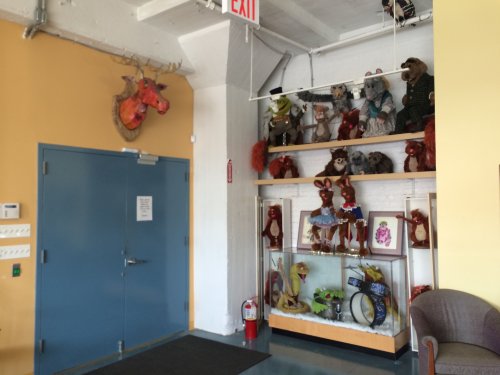
It’s the Jim Henson Creature Shop, which makes and refurbishes all the Sesame Street puppets, as well as characters from other Jim Henson Company productions like Fraggle Rock and Emmett Otter’s Jug Band. The place also works with private companies to make puppets for advertisements and more. And overseeing the whole operation is production manager Melissa Creighton.
Guess you could say she pulls the strings at the puppet workshop.
As Melissa greeted me with a handshake and a broad, warm smile, she explained that the workshop’s primary goal is taking designs made at another Jim Henson Company office and turning them into actual puppets. You won’t find the likes of Kermit or Miss Piggy hanging around here, as the Walt Disney Company owns them now.
As Melissa showed me around the expansive workshop, I saw a host of familiar faces from my childhood TV viewing: Big Bird, Cookie Monster, the Count and others.
Melissa sees these characters every day, working alongside them as she drums up new business, keeps track of puppets being built by the workshop’s team to ship overseas for other countries’ versions of Sesame Street, and many more never-ending tasks for the Creature Shop, owned by the Jim Henson Company.
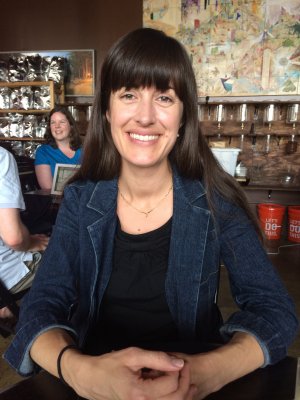
“It’s a big challenge, but I’m loving it,” she said, smiling again.
As I would learn over lunch with Melissa, the job is the perfect culmination of her long-running interest in the creative side of puppetry and her desire to develop her managerial skills. And her affection for the workshop was clear as she showed me everything from the tables of puppet parts being stitched together to reams of foam to a room for painting and woodwork and more. It has all the components of an arts workshop, but this place is creating Oscar the Grouch, Bert and Ernie, and countless other instantly recognizable characters.
While Melissa talked me through the process of building a puppet, she’d often break off her sentences to show me things she thought were cool — a bundle of Cookie Monster’s cookies; paws being stitched for life-size Coca Cola polar bear costumes; googly-eyed birds hanging from the ceiling. Her enthusiasm for workshop’s efforts was infectious.
“I love that a puppet can say something more easily than a person can,” she said as she showed me around the place. “A puppet is appealing because it has that similarity to a toy or doll that everyone has a happy experience of playing with. And I love the world of Sesame Street because it’s so high-end.”
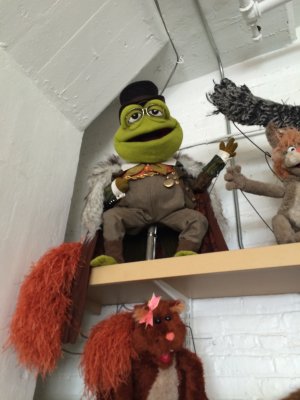
The puppets displayed in the lobby of the workshop are evidence of their top quality. There’s a character called Doc Frog, decked out in a fine suit, fur-lined overcoat and top hat. The closer you get to the puppet, the more you appreciate the work that went into turning a lump of synthetic fur and foam into something that can express a personality without saying a single word.
Melissa said it’s a testament to the legacy of Jim Henson. And tributes to the man are dotted around the workshop. Near the entrance is a frosted glass window, the top pane featuring the perennial Sesame Street roommates Bert and Ernie, the bottom pane Jim Henson and Frank Oz (also known as the voice of Miss Piggy, as well as several other Muppet characters).
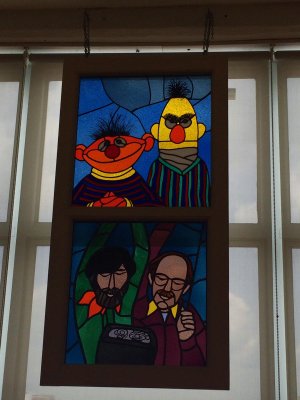
Nearby is a hardwood desk carved with Muppet images that used to grace the entrance of the Jim Henson Company at one of its prior locations in New York City. Nowadays instead of a receptionist the desk is manned by several Sesame Street puppets including Grover. They’re frozen in position, or “armatured,” something the workshop does to puppets that go on display at museums.
The wall behind the desk features a painting of a Sesame Street episode being shot. The way that the puppet magic works is as follows: the “room” of a scene on the show is actually about four feet off the ground, with cameras fixed at that height. The puppeteers are crouching below, manipulating the characters and keeping tabs by looking at monitors underneath them.
When humans are also involved in a scene, things get more physical. Everything’s at actual ground level, and then the puppeteers have to lie on rolling carts and perform. “It’s a very specific kind of athleticism, you need to have a strong arm and endurance,” Melissa said.
She sometimes teaches children the art of puppetry, and says that the kids will complain about being sweaty or cramped. “I say, ‘Welcome to the world of a puppeteer.’”
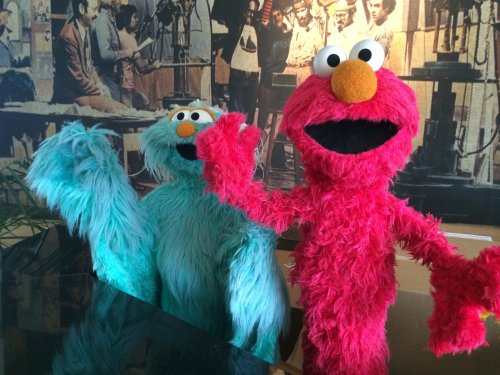
This world is Melissa’s domain, as she is the liaison between business clients and the workshop crew, ensuring everything is done on time and budget. “Our clients are very involved in the beginning of the build of the puppet and the end of the build. And in the middle we ask them to just kind of leave us alone,” she said, chuckling.
Among the steps she’s taking to generate new business are visiting with companies and presenting a short video of different types of advertisements featuring puppets. “Then I stand up and talk about what it is that we do, and what it would be like to work with us,” Melissa said. It’s been a successful approach so far — with three presentations done, they scored at least one job.
“But Sesame Street is our main bread and butter,” she added.
A lot of the workshop’s time is taken up with either fixing and repairing the show’s puppets, or building new props and characters as necessary. For example, Melissa showed me some puppets that would be used in a parody of Jurassic Park called Jurassic Cookie.
“We design and build and repair all the domestic Sesame Street puppets you’re familiar with, but also for Sesame Street around the world,” she said, reeling off a list of overseas productions that includes South Africa, India, Ireland, Germany and the Netherlands. Each has a different core cast of characters, and all of the puppets are shipped out of the New York City workshop.
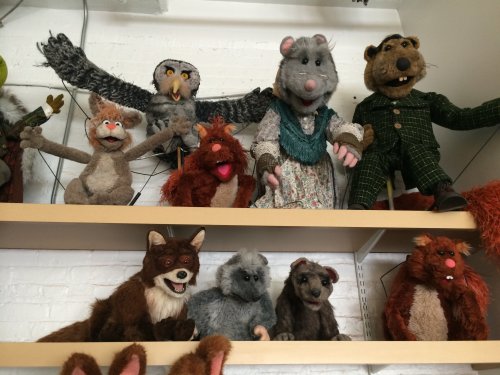
How does Melissa keep track of it all? “Carefully,” she said, laughing.
She even loves the non-puppetry aspects of the job, including the number crunching on the business side because “I’ve always enjoyed math, so that has worked out.” Dealing with many different people is also something she enjoys as she comes from a very large family.
In addition to her production manager role, Melissa continues to develop her own puppet creations in her spare time, including music videos for her singer husband.
Part of the appeal of the furry creatures is that they allow her complete artistic freedom. “Actors are kind of limited in what they can play. But as a puppet, I could play an old man, or a little boy, or a bird. Any kind of character,” she said. “And then — oh, you should take a picture of this.”
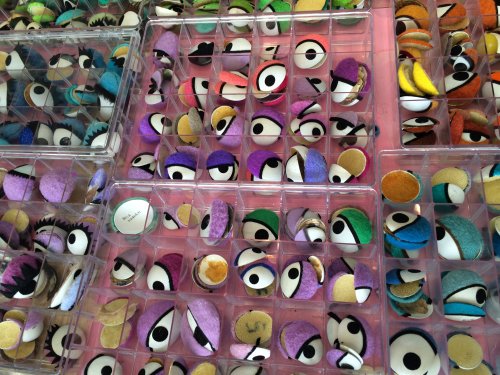
She’d stopped to pull open a drawer of eyeballs. Puppet eyeballs. It was an overwhelming sight at first, all those different goofy pupils staring back at me. But it’s a good example of the attention to detail and ingenious thinking that the workshop uses. The eyeballs could be made of household objects like ping pong balls, but then the designers figure out exactly what shape to give the eyes, whether it should have an eyelid, and, if so, what material to use for the eyelid. Should the eyes stare forward, or be off-center? Important questions if you’re a puppeteer.
Melissa wanted to be a puppeteer ever since she went to university, as I’d learn when we got lunch following the tour. She recommended COFFEED, in the same building as the workshop. It’s a bright, roomy space with high ceilings, apparently popular with a 20- and 30-something crowd. The place offers sandwiches, coffee and other lunchtime snacks.
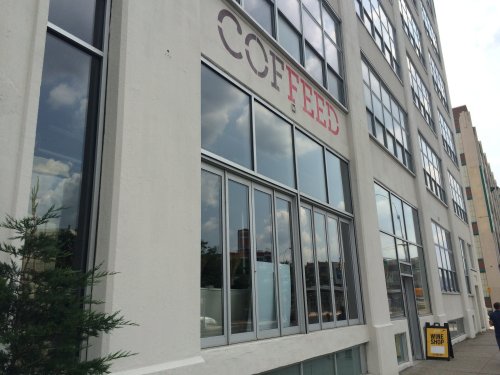
After placing our orders and finding a table, Melissa said that she didn’t initially have a passion for puppetry when growing up in Minnesota. Although she loves her home state — apparently the term “Minnesota nice” is a real thing because the people out there are friendly — she always had a desire to live in New York. “It seemed like the big city, the Paris of the U.S.”
Before the Big Apple, she went to university in Chicago as a film major with a fair amount of theater studies as well. “I’d been performing my whole life but didn’t really get interested in puppetry until my junior year,” Melissa said. She went with friends on a trip to Vermont to see the Resurrection Circus hosted by Bread and Puppet Theater, a decades-old puppet show with a radical political bent. “It’s a fun, weird kind of subversive performance,” she said, the spectacle featuring an outdoors parade of puppets.
As part of the annual weekend festivities there are also smaller performances, and that’s where Melissa saw puppeteer Paul Zaloom perform. Best known as the eccentric scientist Beakman on children’s show Beakman’s World, Zaloom impressed Melissa with a table-top performance turning everyday objects like soda cans into puppets.
“I was totally transfixed,” she said.
Returning to college, she started to experiment with puppetry and did at least one performance piece with friends. After graduation, she moved to New York.
One early job 14 years ago was with the Jim Henson Company. She worked as photo coordinator for a year, a largely administrative job putting together estimates and hiring people for photo shoots.
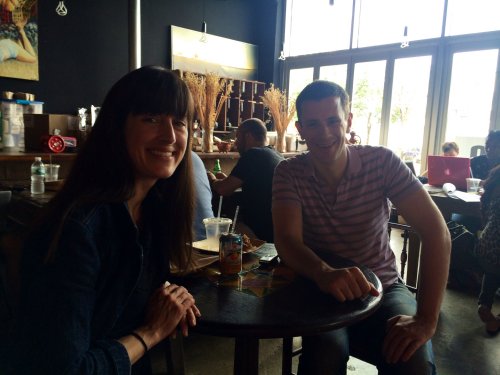
“I ended up leaving to do more stuff with my hands at scenic shops and art departments,” she said. Among her various gigs was work with the Puppeteers’ Cooperative, a spin-off company from the Bread and Puppet Theater. She also experimented with jobs including a production assistant driving vans and picking up materials for puppet shows, and taking part in puppet festivals in the city.
Eventually she ran into old friends from the Jim Henson Company who were putting together a pitch for a proposed puppet feature film, and she worked with them on it. The movie never happened, but the effort got her focused back on puppetry.
Later work included building the puppets for Avenue Q, a decidedly adult musical that’s a spin on Sesame Street, with humans and puppets learning life lessons together, except with swear words and sexual innuendo.
She also did work on the children’s television show It’s A Big, Big World playing the character Burdette. And she would spend her private time working on her own projects in a small workshop in her basement.
“Always there was this puppetry thread through everything that I’ve done and it kind of led me back here,” Melissa said in reference to the Jim Henson Company. She’s been back at the company for about a year-and-a-half, bringing her back to Sesame Street.
Working out of the Long Island City office also means she has easy access to COFFEED, and after our lunch there I have to say I’m quite jealous. The sandwiches were great.
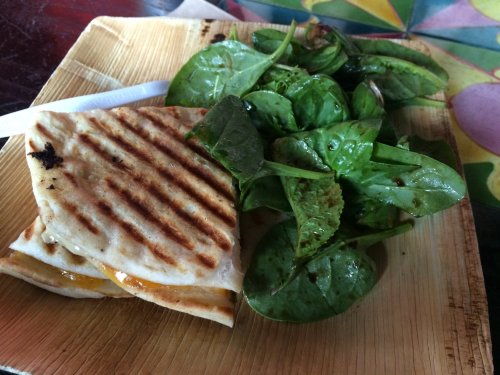
I ordered the cheese panini — provolone, Swiss and cheddar with greens on pressed pita bread. The warm, gooey sandwich was wonderful. Not greasy or too heavy, and the cheese fresh and tasty.
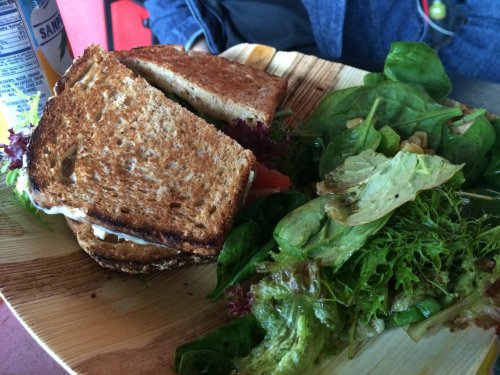
Melissa went for the tuna sandwich with celery, onions, carrots, tomato, fresh greens, and said she enjoyed it. I can see why she’s a regular at the place, because of its great value food and generous portions. The younger crowd gives it a lively atmosphere, and Melissa fit right in with her upbeat attitude and friendly nature.
Her apparent optimistic nature likely helps immensely with her work at the Jim Henson Company, but it also benefits the puppetry side projects she does in her spare time.
Melissa is married to musician Matt Singer, and she has created puppets for the videos to the songs “I Do” and “All This Joy,” both of them featuring colorful creatures.
Among her works are short puppetry pieces including the skit “What’s Up!” which she said she’s most proud of, another called “Hero” and more. Viewing them, her joyful nature reveals itself in the comical, largely upbeat performances.
Melissa and her husband are raising a baby and she said that her time is consumed evenly with the Creature Shop, her personal puppetry, and her son. “He’s the biggest and best thing in my life right now, he’s awesome. He sees the puppets a lot when he comes to visit at work,” she said.
And her day job continues to keep her motivated.
“I love it here,” she said of the Creature Shop. “When you’re performing, you’re affecting a large group of people in that moment. But I wanted to be a part of something that was more lasting. Being a part of what’s going on in the shop and learning what it takes to be a really effective leader is important to me. It’s a lot of work, and a big challenge, but I’m happy.”
As we finished our lunch, Melissa thought about her career trajectory that first brought her to the Jim Henson Company, and then 14 years later back to the same place. “I didn’t grow up wanting to be a puppeteer. I was just following my bliss. And I had been riding a wave of freelance work, but I felt the wave breaking, and I wanted to have a full-time job. So now I’m a part of the Jim Henson Company again. And puppetry has always been the through-line.”
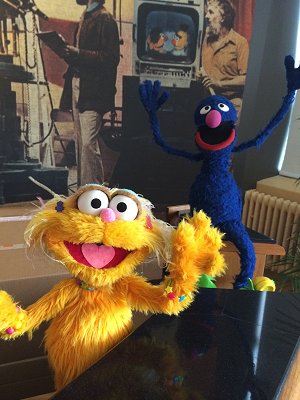
She has nothing but praise for her employees at the Creature Shop, saying “it’s a whole team of people working to make it happen, and I’m just facilitating that work. But to me, it’s a grand assignment. Every day I go home and I’m not done. There’s always more to do.”
After a quick handshake and goodbye, I stepped out into the city to head back to Washington, DC. Melissa traveled the few floors upstairs to the Creature Shop, opening up the double-doors leading in to the puppet shop, and dove back in to her ideal job in the land of Sesame Street.
520yo3
ij45gb